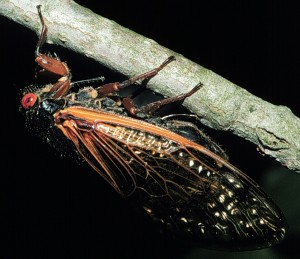No insect creates more newspaper headlines than the periodical cicada (Magicicada spp.). Their sudden emergence, every 13 or 17 years reads like a chapter from a science fiction novel. Their high-pitched noise or “mating call” fills the late spring air.
Both the 13-year and 17-year cicadas are uniquely common in the eastern U.S., found no other place on Earth. The two populations, called “broods”, emerge at different times, that is, 13- or 17-year intervals depending on the locale.
Early American colonists thought they were a “locust plague”. People often confuse cicadas and locusts. A locust is actually a species of grasshoppers and feeds on foliage. An adult cicada does not feed on foliage, but feeds on twig sap. The female cicada makes injurious slits in twigs and limbs of trees to deposit eggs.
The adult periodical cicada is 1 to 1½ inches long (photo). The body is black, while the legs, eyes and wing veins which are reddish-orange. Large numbers of adults emerge in May or June when the soil temperature 4 inches deep reaches 67° F. Four or five days after emergence, the males start their high-pitched mating call to attract females. Mating occurs and females begin laying eggs.
The female cicada has a knife-like ovipositor that she uses to slit twigs of woody plants. Apple, pear, dogwood, oak and hickory are among their favorite host plants. In each slit, the female lays 24 to 28 eggs. Each female can lay a total of 400 to 600 eggs. Pencil thickness wood is the main target. Young trees are very susceptible to severe injury.
Preventative measures should be in place to protect young trees and shrubs. Pruning should be delayed until after cicada emergence so damaged branches can be removed. Cover small woody landscape and fruit trees with cheesecloth or spun row cover for protection while cicadas are present. Insecticide spraying are not an effective option.
* Special thank you to Dr. Frank Hale, Univ. of Tennessee Entomologist for providing information on cicada life cycle.


 Posted in
Posted in 
